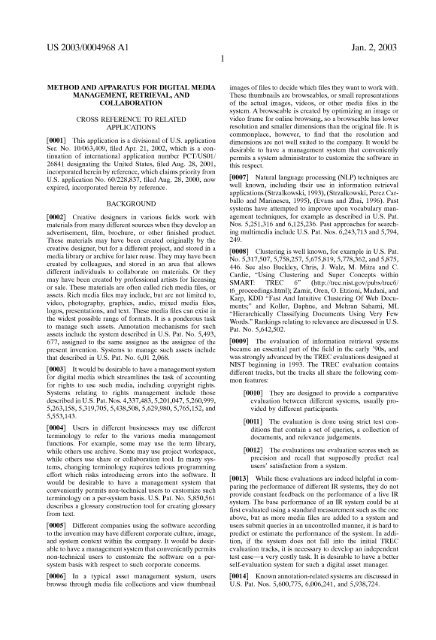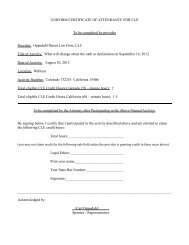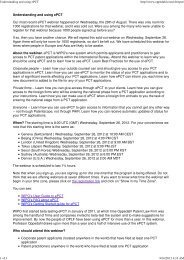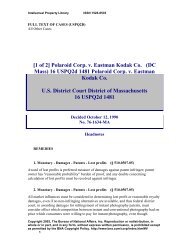Patent Application Publication (10) pub. NO.: US 2003/0004968 A1
Patent Application Publication (10) pub. NO.: US 2003/0004968 A1
Patent Application Publication (10) pub. NO.: US 2003/0004968 A1
Create successful ePaper yourself
Turn your PDF publications into a flip-book with our unique Google optimized e-Paper software.
Jan. 2,<strong>2003</strong><br />
METHOD AND APPARAT<strong>US</strong> FOR DIGITAL MEDIA<br />
MANAGEMENT, RETRIEVAL, AND<br />
COLLABORATION<br />
CROSS REFERENCE TO RELATED<br />
APPLICATIONS<br />
[0001] This application is a divisional of U.S. application<br />
Ser. No. <strong>10</strong>/063,409, filed Apr. 21, 2002, which is a continuation<br />
of international application number PCT/<strong>US</strong>Ol/<br />
26841 designating the United States, filed Aug. 28, 2001,<br />
incorporated herein by reference, which claims priority from<br />
U.S. application No. 601228,837, filed Aug. 28, 2000, now<br />
expired, incorporated herein by reference.<br />
BACKGROUND<br />
[0002] Creative designers in various fields work with<br />
materials from many different sources when they develop an<br />
advertisement, film, brochure, or other finished product.<br />
These materials may have been created originally by the<br />
creative designer, but for a different project, and stored in a<br />
media library or archive for later reuse. They may have been<br />
created by colleagues, and stored in an area that allows<br />
different individuals to collaborate on materials. Or thev<br />
may have been created by professional artists for licensing<br />
or sale. These materials are often called rich media files, or<br />
assets. Rich media files may include, but are not limited to,<br />
video, photography, graphics, audio, mixed media files,<br />
logos, presentations, and text. These media files can exist in<br />
the widest possible range of formats. It is a ponderous task<br />
to manage-such assets. Annotation mechanisms for such<br />
assets include the system described in U.S. Pat. No. 5,493,<br />
677, assigned to the same assignee as the assignee of the<br />
present invention. Systems to manage such assets include<br />
that described in U.S. Pat. No. 6,01 2,068.<br />
[0003] It would be desirable to have a management system<br />
for digital media which streamlines the task of accounting<br />
for rights to use such media, including copyright rights.<br />
Systems relating to rights management include those<br />
described in U.S. Pat. Nos. 4,337,483,5,201,047,5,260,999,<br />
5,263,158,5,319,705,5,438,508,5,629,980,5,765,152, and<br />
5,553,143.<br />
[0004] Users in different businesses may use different<br />
terminology to refer to the various media management<br />
functions. For example, some may use the term library,<br />
while others use archive. Some may use project workspace,<br />
while others use share or collaboration tool. In many systems,<br />
changing terminology requires tedious programming<br />
effort which risks introducing errors into the software. It<br />
would be desirable to have a management system that<br />
conveniently permits non-technical users to customize such<br />
terminology on a per-system basis. U.S. Pat. No. 5,850,561<br />
describes a glossary construction tool for creating glossary<br />
from text.<br />
[0005] Different companies using the software according<br />
to the invention may have different corporate culture, image,<br />
and system context within the company. It would be desirable<br />
to have a management system that conveniently permits<br />
non-technical users to customize the software on a persystem<br />
basis with respect to such corporate concerns.<br />
[0006] In a typical asset management system, users<br />
browse through media file collections and view thumbnail<br />
images of files to decide which files they want to work with.<br />
These thumbnails are browseables, or small representations<br />
of the actual images, videos, or other media files in the<br />
system. A browseable is created by optimizing an image or<br />
video frame for online browsing, so a browseable has lower<br />
resolution and smaller dimensions than the original file. It is<br />
commonplace, however, to find that the resolution and<br />
dimensions are not well suited to the company. It would be<br />
desirable to have a management system that conveniently<br />
permits a system administrator to customize the software in<br />
this respect.<br />
[0007] Natural language processing (NLP) techniques are<br />
well known, including their use in information retrieval<br />
applications (Strzalkowski, 1993), (Strzalkowski, Perez Carballo<br />
and Marinescu, 1995), (Evans and Zhai, 1996). Past<br />
systems have attempted to improve upon vocabulary management<br />
techniques, for example as described in U.S. Pat.<br />
Nos. 5,251,316 and 6,125,236. Past approaches for searching<br />
multimedia include U.S. Pat. Nos. 6,243,713 and 5,794,<br />
249.<br />
[0008] Clustering is well known, for example in U.S. Pat.<br />
No. 5,317,507,5,758,257, 5,675,819,5,778,362, and 5,875,<br />
446. See also Buckley, Chris, J. Walz, M. Mitra and C.<br />
Cardie, "Using Clustering and Super Concepts within<br />
SMART: TREC 6" (http:/ltrec.nist.gov/<strong>pub</strong>s/trec6/<br />
t6qroceedings.html); Zamir, Oren, 0. Etzioni, Madani, and<br />
Karp, KDD "Fast And Intuitive Clustering Of Web Documents;"<br />
and Koller, Daphne, and Mehran Sahami, ML<br />
"Hierarchically Classifying Documents Using Very Few<br />
Words." Rankings relating to relevance are discussed in U.S.<br />
Pat. No. 5,642,502.<br />
[0009] The evaluation of information retrieval systems<br />
became an essential part of the field in the early '90s, and<br />
was strongly advanced by the TREC evaluations designed at<br />
NIST beginning in 1993. The TREC evaluation contains<br />
different tracks, but the tracks all share the following common<br />
features:<br />
[00<strong>10</strong>] They are designed to provide a comparative<br />
evaluation between different systems, usually provided<br />
by different participants.<br />
[OOll] The evaluation is done using strict test conditions<br />
that contain a set of queries, a collection of<br />
documents, and relevance judgements.<br />
[0012] The evaluations use evaluation scores such as<br />
precision and recall that supposedly predict real<br />
users' satisfaction from a system.<br />
[0013] While these evaluations are indeed helpful in comparing<br />
the performance of different IR systems, they do not<br />
provide constant feedback on the performance of a live IR<br />
system. The base performance of an IR system could be at<br />
first evaluated using a standard measurement such as the one<br />
above, but as more media files are added to a system and<br />
users submit queries in an uncontrolled manner, it is hard to<br />
predict or estimate the performance of the system. In addition,<br />
if the system does not fall into the initial TREC<br />
evaluation tracks, it is necessary to develop an independent<br />
test case-a very costly task. It is desirable to have a better<br />
self-evaluation system for such a digital asset manager.<br />
[0014] Known annotation-related systems are discussed in<br />
U.S. Pat. Nos. 5,600,775, 6,006,241, and 5,938,724.





